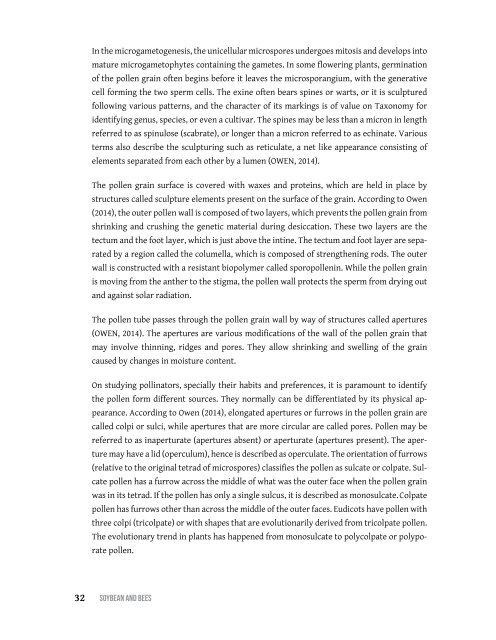Soybean and Bees
You also want an ePaper? Increase the reach of your titles
YUMPU automatically turns print PDFs into web optimized ePapers that Google loves.
In the microgametogenesis, the unicellular microspores undergoes mitosis <strong>and</strong> develops into<br />
mature microgametophytes containing the gametes. In some flowering plants, germination<br />
of the pollen grain often begins before it leaves the microsporangium, with the generative<br />
cell forming the two sperm cells. The exine often bears spines or warts, or it is sculptured<br />
following various patterns, <strong>and</strong> the character of its markings is of value on Taxonomy for<br />
identifying genus, species, or even a cultivar. The spines may be less than a micron in length<br />
referred to as spinulose (scabrate), or longer than a micron referred to as echinate. Various<br />
terms also describe the sculpturing such as reticulate, a net like appearance consisting of<br />
elements separated from each other by a lumen (Owen, 2014).<br />
The pollen grain surface is covered with waxes <strong>and</strong> proteins, which are held in place by<br />
structures called sculpture elements present on the surface of the grain. According to Owen<br />
(2014), the outer pollen wall is composed of two layers, which prevents the pollen grain from<br />
shrinking <strong>and</strong> crushing the genetic material during desiccation. These two layers are the<br />
tectum <strong>and</strong> the foot layer, which is just above the intine. The tectum <strong>and</strong> foot layer are separated<br />
by a region called the columella, which is composed of strengthening rods. The outer<br />
wall is constructed with a resistant biopolymer called sporopollenin. While the pollen grain<br />
is moving from the anther to the stigma, the pollen wall protects the sperm from drying out<br />
<strong>and</strong> against solar radiation.<br />
The pollen tube passes through the pollen grain wall by way of structures called apertures<br />
(Owen, 2014). The apertures are various modifications of the wall of the pollen grain that<br />
may involve thinning, ridges <strong>and</strong> pores. They allow shrinking <strong>and</strong> swelling of the grain<br />
caused by changes in moisture content.<br />
On studying pollinators, specially their habits <strong>and</strong> preferences, it is paramount to identify<br />
the pollen form different sources. They normally can be differentiated by its physical appearance.<br />
According to Owen (2014), elongated apertures or furrows in the pollen grain are<br />
called colpi or sulci, while apertures that are more circular are called pores. Pollen may be<br />
referred to as inaperturate (apertures absent) or aperturate (apertures present). The aperture<br />
may have a lid (operculum), hence is described as operculate. The orientation of furrows<br />
(relative to the original tetrad of microspores) classifies the pollen as sulcate or colpate. Sulcate<br />
pollen has a furrow across the middle of what was the outer face when the pollen grain<br />
was in its tetrad. If the pollen has only a single sulcus, it is described as monosulcate. Colpate<br />
pollen has furrows other than across the middle of the outer faces. Eudicots have pollen with<br />
three colpi (tricolpate) or with shapes that are evolutionarily derived from tricolpate pollen.<br />
The evolutionary trend in plants has happened from monosulcate to polycolpate or polyporate<br />
pollen.<br />
32 SoybeAn <strong>and</strong> bees


